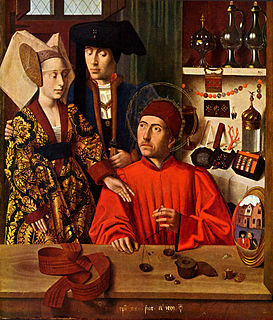
Year 660 (DCLX) was a leap year starting on Wednesday of the Julian calendar. The denomination 660 for this year has been used since the early medieval period, when the Anno Domini calendar era became the prevalent method in Europe for naming years.

Baekje also called Nambuyeo, was a Korean kingdom located in southwestern Korea from 18 BC – 660 AD. It was one of the Three Kingdoms of Korea, together with Goguryeo and Silla.

North Jeolla Province, also known as Jeonbuk, is a province of South Korea. North Jeolla has a population of 1,869,711 (2015) and has a geographic area of 8,067 km2 located in the Honam region in the southwest of the Korean Peninsula. North Jeolla borders the provinces of South Jeolla to the south, North Gyeongsang and South Gyeongsang to the east, North Chungcheong to the northeast, and South Chungcheong to the north.

The Geum River is located in South Korea. It is a major river that originates in Jangsu-eup, North Jeolla Province. It flows northward through North Jeolla and North Chungcheong Provinces and then changes direction in the vicinity of Greater Daejeon and flows southwest through South Chungcheong Province before emptying into the Yellow Sea near Gunsan city.
Gyebaek or Kyebaek was a general in the ancient Korean kingdom of Baekje during the early to mid 7th century. Little else is known of his personal life—including the year and location of his birth.
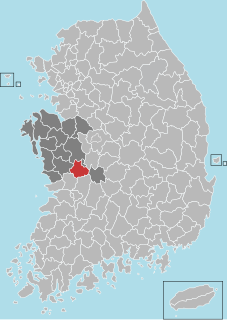
Nonsan is a city in South Chungcheong Province, South Korea. It is located at 36°12′N127°5′E. The origin of Nonsan's geographical names is said to have come from the small garden " Nolmoe, " which rises in the middle of farming fields, where rice paddies and mountain are said to reflect geographical features. The city belongs to the Daejeon Metropolitan Area.
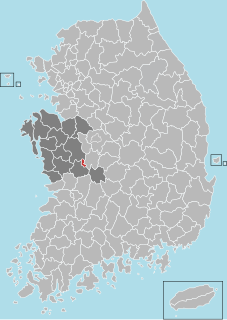
Gyeryong is a city in southeastern South Chungcheong province, South Korea. The current mayor is Choi Hong-Mook. The city was created in 2003, by a split from Nonsan city, following prolonged local agitation.

Mireuksa was the largest Buddhist temple in the ancient Korean kingdom of Baekje. The temple was established in 602 by King Mu and is located 36.012083 N, 127.031028 E, modern Iksan, North Jeolla Province, South Korea. The site was excavated in 1980, disclosing many hitherto unknown facts about Baekje architecture. Mireuksaji Stone Pagoda is one of two extant Baekje pagodas. It is also the largest as well as being among the oldest of all Korean pagodas.
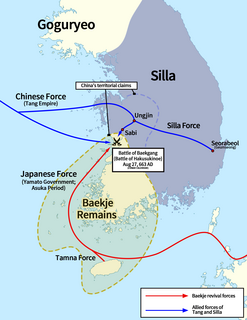
The Battle of Baekgang or Battle of Baekgang-gu, also known as Battle of Hakusukinoe in Japan, as Battle of Baijiangkou in China, was a battle between Baekje restoration forces and their ally, Yamato Japan, against the allied forces of Silla and the Tang dynasty of Imperial China. The battle took place in the Baengma River or Baek River, which is the lower reach of the Geum River in Jeollabuk-do province, Korea. The Silla-Tang forces won a decisive victory, compelling Yamato Japan to withdraw completely from Korean affairs and crushing the Baekje restoration movement.

Rundāle Palace is one of the two major baroque palaces built for the Dukes of Courland in what is now Latvia, the other being Jelgava Palace. The palace was built in two periods, from 1736 until 1740 and from 1764 until 1768. It is situated at Pilsrundāle, 12 km west of Bauska.

Gyeryongsan, a 845 m (2,772 ft) mountain in Chungcheongnam-do, South Korea. It lies at the meeting of the boundaries of several cities: Gongju, Gyeryong, Nonsan, and Daejeon. It has been traditionally regarded as a sacred mountain, with the most qi of any in South Korea. The name Gyeryongsan means chicken dragon mountain. Portions of the mountain are included in a South Korean military reserve. Other portions are part of Gyeryongsan National Park. In the mountain, there are famous Buddhist temples such as Donghaksa, Gapsa and Sinwonsa, the latter two both being over a thousand years old. In addition the highest peak, Cheonhwangbong, there are seven other peaks with an elevation exceeding 500m
Geumgang University is a South Korean Buddhist university with a residential college model, located in the countryside next to Gyeryong Mountain, between Nonsan and Daejeon. The campus is within the administrative boundaries of Nonsan's Sangwol-myeon district. The university is operated by the Cheontae Buddhist sect headquartered at Guinsa.

The Tomb of King Muryeong, also known as Songsan-ri Tomb No. 7, is the ancient tumulus of King Muryeong, who ruled the Baekje from 501 to 523, and his queen. The rarity of intact Baekje tombs makes this one of the major archaeological discoveries in Korea and a crucial source for the understanding of Baekje, one of the Three Kingdoms of Korea.
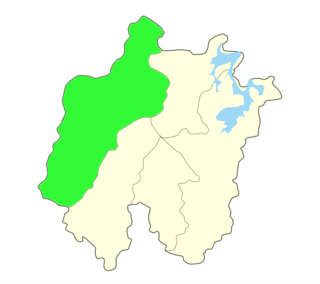
Yuseong District (Yuseong-gu) is a gu ("district") of Daejeon, South Korea, known for high tech industries, Daejeon Expo '93, Daedeok Science Town and the Yuseong Special Tourism District. Daejeon Islamic Center is also located in Kung-dong, Yuseong-gu. The Science Town is the core of the International Science and Business Belt.
Yeonsan-myeon is a part of Nonsan, South Korea. It is a small township (-myeon), located on the rail line between Nonsan proper and Daejeon. It holds an annual jujube festival, and Hanmin University is located in Yeonsan.

The Grove Park, or The Grove is a public park in Carshalton in the London Borough of Sutton. It is situated close to Carshalton Village in the area approximately bounded by the High Street, North Street and Mill Lane. The southwest corner of the park abuts one of Carshalton's ponds from where water flows through the park as the river Wandle.
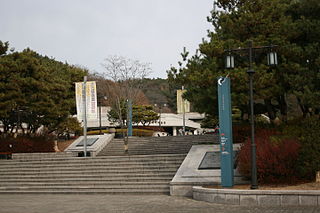
Buyeo National Museum is a national museum located in Buyeo, Chungcheongnam-do, South Korea. Since Buyeo was once the capital of the Baekje kingdom during the Sabi period (538-660), the Museum is fully devoted to the Baekje culture.
Cheonan Junction, shortly Cheonan JC, is a junction located in Dongnam-gu, Cheonan, South Chungcheong, South Korea. Gyeongbu Expressway, Nonsan–Cheonan Expressway, and Asan–Cheongju Expressway meet here. The type of junction is Y-shape junction. Asan–Cheongju Expressway will be opened, and Cheonan JC – Oksan JC segment will be overlapped with Gyeongbu Expressway and Asan–Cheongju Expressway in January 2018.
The Ungjin Commandery was a Tang Dynasty Chinese colony set up for the purpose of governing the former Baekje area of the Korean peninsula, today's North and South Korea after the Tang defeat of Baekje and Goguryeo. The Tang dynasty incorporated the old territorial area of Baekje into Goguryeo, the Protectorate General to Pacify the East, Ungjin Commandery and Gyerim Territory Area Command. Those political organizations were newly set and Tang dynasty renamed the Korean peninsula under the Jimi system.
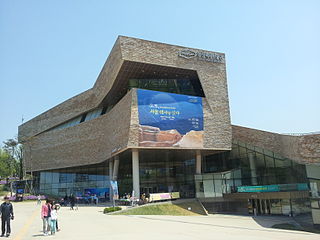
Seoul Baekje Museum (Korean: 한성백제박물관) is a museum in South Korea. Based on the natural silhouette of the nearby Mongchontoseong, the appearance of Seoul Baekje Museum was shaped a ship of Baekje in honor of Baekje. Seoul Baekje Museum is a civic lifelong education center with an emphasis on the educational role. There are a variety of Baekje artifacts and vividly embodied materials on ancient history of the Korean peninsula.














